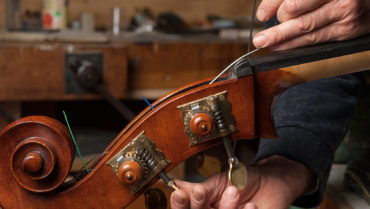

Patient Characteristics and Outcomes of Retained Lens Fragments in the Anterior Chamber After Uneventful Phacoemulsification
Norton JC, Goyal S1
ABSTRACT SUMMARY
Few large studies have been conducted to identify risk factors for retained lens fragments after uncomplicated phacoemulsification. Postoperative inflammation due to retained lens fragments, although rare, can worsen BCVA. Norton and Goyal examined common factors in cases of retained nuclear fragments and assessed the impact of timely intervention.
They performed a retrospective review of 4,367 cataract cases and identified 19 patients (an incidence of 0.44%) with retained nuclear material. The mean age of the 15 women and four men was 72.68 years. The mean axial length was 23.58 mm, and the mean keratometry reading was 44.62 D. Mean preoperative anterior chamber depth was 2.97 mm, but preoperative data for one patient were missing.
Patients with retained lens fragments most commonly presented with anterior chamber inflammation (72.2%) and corneal edema (52.6%). Fragments were usually located in the anterior chamber angle (89.5%), and the vast majority of cases were diagnosed on slit-lamp examination.
STUDY IN BRIEF
• A retrospective review of cases of retained lens fragments after uncomplicated cataract surgery determined that long eyes, steep corneas, and shallow anterior chamber depths may be risk factors for the problem. Prompt identification and surgical removal provided the best visual outcomes.
WHY IT MATTERS
Based on these research findings, ophthalmologists can more readily identify patients at significant risk of retained lens fragments, especially when confronted with prolonged anterior chamber inflammation and corneal edema. Specifically, although some previous studies have suggested that deep anterior chambers pose a potential risk, that was not the case in this study.
The mean time between cataract extraction and diagnosis of a retained nuclear fragment was 24.4 days. An average of 9.58 days elapsed between identification of the fragment and a corrective surgical procedure. The five patients who developed complications had retained fragments longer (mean, 14.4 days) than the 14 who did not (mean, 8.4 days).
DISCUSSION
Retained nuclear fragments are a rare occurrence after cataract surgery, but this study identified several risk factors. Among patients with persistent postoperative inflammation, those with a shallow anterior chamber, normal to long axial length, and steep cornea could be at risk.
Because the vast majority of retained lens fragments are present in the inferior angle of the anterior chamber, any patient who presents with corneal edema or inflammation after cataract extraction, especially with inferior wedge edema, should receive a thorough slit-lamp examination. Gonioscopy is also an important diagnostic tool to visualize the inferior angle.
When a fragment is identified, prompt surgical intervention is necessary to lessen the risk of postoperative retinal complications, including cystoid macular edema, or corneal complications.
Comparison of the Rotational Stability of Two Toric Intraocular Lenses in 1,273 Consecutive Eyes
Lee BS, Chang DF2
ABSTRACT SUMMARY
The optimal use of a toric IOL is to manage clinically significant astigmatism at the time of cataract surgery. Doing so depends on the surgeon’s ability to align the toric lens with the desired axis of corneal astigmatism and the IOL’s ability to remain in that axis (ie, its rotational stability). Lee and Chang investigated the rotational stability of the AcrySof IQ Toric IOL (Alcon) and the Tecnis Toric 1-Piece IOL (Johnson & Johnson Vision). The IOL axis was confirmed at the end of each case and within 24 hours after surgery.
The investigators performed a retrospective cohort study examining the frequency and amount of IOL rotation in 1,273 eyes. Surgical technique was consistent in all cases. Aphakic aberrometry confirmed the IOL selection, and pseudophakic aberrometry was used to adjust the axis of the IOL intraoperatively. All OVD was removed from the capsular bag with thorough irrigation and aspiration. At the end of the case, a digital marking system confirmed that the IOL markings were aligned with the toric positioning lines. The eyes were left soft (with IOP in single digits) “to avoid capsular bag distension,” according to the investigators.
Patients underwent dilated examinations on postoperative day 0 or 1 to check the toric IOL axis alignment. They were offered repositioning surgery if they had a misaligned IOL, refractive cylinder greater than 0.75 D, and 20/30 UCVA or worse.
Of the 626 eyes that received the AcrySof IQ Toric IOL, 91.9% exhibited rotation of 5º or less from the target axis at the first postoperative check compared with 81.8% of the 647 eyes that received the Tecnis Toric 1-Piece IOL (P < .0001). The numbers of eyes exhibiting rotation of 10º or less and of 15º or less were statistically greater in the AcrySof group. The mean absolute value of rotation was 2.72º for AcrySof IQ Toric IOLs and 3.79º for Tecnis Toric 1-Piece IOLs. The Tecnis IOLs tended to rotate counterclockwise. Conversely, large rotations of the AcrySof lens tended to be clockwise, particularly in eyes that had with-the-rule astigmatism.
STUDY IN BRIEF
• Investigators compared the rotational stability of two commonly used toric IOLs. Overall, rates of malrotation were low, and implantation of either IOL resulted in excellent visual outcomes. The AcrySof IQ Toric IOL showed significantly greater rotational stability.
WHY IT MATTERS
The risk of toric IOL rotation may be decreased by continued advances in lens material and design. This study provides insight into when and why toric IOLs rotate.
Most patients achieved successful refractive outcomes despite any observed IOL misalignment, which is known to decrease the efficacy of toric IOLs. Refractive outcomes were equivalent between the two groups, with mean postoperative refractive cylinder of 0.30 D for the AcrySof IQ Toric IOL and 0.31 D for the Tecnis Toric 1-Piece IOL. BCVA was 20/40 or better in 99.2% of AcrySof eyes and in 99.8% of Tecnis eyes. Toric IOL repositioning was a rare event, and there was no statistically significant difference in its occurrence between groups (1.6% AcrySof vs 3.1% Tecnis, P = .1).
DISCUSSION
This is the first study to look at the rotational stability of these commonly used toric IOLs prior to the first postoperative visit. Recent research suggested that the most likely time for a toric IOL to rotate is within the first postoperative hour.3 This seems likely because the results Lee and Chang observed on postoperative day 0 and postoperative day 1 were identical. In light of this finding, surgeons should consider limiting patient activity immediately after cataract surgery with toric IOL implantation.
The investigators speculated that the acrylic lens material and its interaction with the capsular bag; the width, angulation, or design of the haptics; or the optic-haptic junction characteristics of the Tecnis Toric 1-Piece IOL might cause it to rotate counterclockwise. Regardless, given the difference in rotational stability, it is not surprising that there was a trend in the study toward more surgical repositioning with the Tecnis Toric 1-Piece IOL. Fortunately, significant postoperative toric IOL misalignment was rare.
This study provides useful information for cataract surgeons. First, it confirmed that there is a sweet spot: toric IOL alignment within 5º from the target axis confers good UCVA without compromising refractive outcome. Second, the study described the rotational stability of two toric IOLs during the first 24 hours after surgery and the associated refractive impact. Perhaps leaving eyes at a normotensive IOP at the end of surgery could improve the rotational stability of toric IOLs. A low IOP makes it difficult to confirm that the wound is secure, and leaks can allow the lens complex to move anteriorly.
1. Norton JC, Goyal S. Patient characteristics and outcomes of retained lens fragments in the anterior chamber after uneventful phacoemulsification. J Cataract Refract Surg. 2018;44(7):848-855.
2. Lee BS, Chang DF. Comparison of the rotational stability of two toric intraocular lenses in 1273 consecutive eyes. Ophthalmology. 2018;125(9):1325-1331.
3. Inoue Y, Takehara H, Oshika T. Axis misalignment of toric intraocular lens: placement error and postoperative rotation. Ophthalmology. 2017;124(9):1424-1425.




